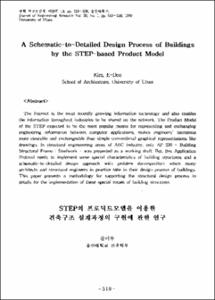대학 캠퍼스의 물리적 환경인지 및 이용행태에 관한 연구
- Alternative Title
- Environmental Cognition and Usage Behavior on University Campus-Focused on cognitive map
- Abstract
- 본 연구는 대학캠퍼스가 교육적 공간으로 갖는 영향력의 중요성을 인식하고 사용자의 관점에서 보다 쾌적하고 합리적인 대학 캠퍼스의 환경계획을 위?? 기초자료제공을 목적으로 한다. 조사대상자는 울산대학교의 학부생 및 대학원생 53명을 대상으로 하여 물리적 환경에 대한 환경인지 및 이용행태를 조사하였다. 조사대상자에 의해 작성된 인지도는 특성별로 3가지 유형(공간강조형, 도로강조형, 복합형)으로 분류되었다. 모든 조사대상자들의 일일 캠퍼스 사용시간은 10시간 이상, 일주일에 4-5일 이상 사용하고 있었으며 캠퍼스 안내의 수단은 건물 중심이 가장 많이 나타났으며, 캠퍼스 연상대상에 있어서는 상징탑이 가장 많이 조사되었으며 인지도상 가장 자주 그려진 건물은 문수관(83%)이었다. 환경태도에 있어 대부분이 보통 이하의 부정적인 태도를 가지고 있었으며 특히 휴식공간에 대해 부정적이었다. 인지도에 있어 건물 수는 연령 및 생활기간의 증가에 따라 많아지는 경향을 보였으며, 인지도유형 분류에서 공간강조형(50.9%)이 가장 많았는데 이는 선행연구와 일치한 결과로 캠퍼스내 이동수단과도 관계가 있는 것으로 나타났다. 캠퍼스 안내의 기준 및 연상건물 등의 결과에서 나타났듯이 대학 캠퍼스 계획시 랜드마크의 역할을 이해하고 위치 및 상징성을 중요하게 고려해야 할 것이다.
The purpose of this study was to recognize the importance of university campus as an educational space and give basic informations to design the environment of university campus more convenient and efficient in user's perspective. The sample consisted of fifty-three undergraduate and graduate students who attend the University of Ulsan. For this study, environmental cognition and attitude for physical environments were investigated. It was found that all students had stayed in the campus over ten hours per a day and approximately four or five days per a week. Most of subjects regarded buildings as the means of guidance. As an environmental attitude, most of the students showed negative reactions, especially lack of space for rest. The cognitive map was classified three types by the content of buildings and paths: space-emphasized type, road-emphasized type and complex type. As the age and usage period increase, the number of building tended to increase. The most recognizable building was Sang-Jing. Tower and the most frequently drawn building in the cognitive map was Mun-Su building(83%). This result implies that the importance of landmark when planning the university campus. This study also reveals that the usage period is an important factor for campus cognition. As a conclusion, the campus must be designed based on the user's perspective especially their environmental attitude and cognition.
The purpose of this study was to recognize the importance of university campus as an educational space and give basic informations to design the environment of university campus more convenient and efficient in user's perspective. The sample consisted of fifty-three undergraduate and graduate students who attend the University of Ulsan. For this study, environmental cognition and attitude for physical environments were investigated. It was found that all students had stayed in the campus over ten hours per a day and approximately four or five days per a week. Most of subjects regarded buildings as the means of guidance. As an environmental attitude, most of the students showed negative reactions, especially lack of space for rest. The cognitive map was classified three types by the content of buildings and paths: space-emphasized type, road-emphasized type and complex type. As the age and usage period increase, the number of building tended to increase. The most recognizable building was Sang-Jing. Tower and the most frequently drawn building in the cognitive map was Mun-Su building(83%). This result implies that the importance of landmark when planning the university campus. This study also reveals that the usage period is an important factor for campus cognition. As a conclusion, the campus must be designed based on the user's perspective especially their environmental attitude and cognition.
- Issued Date
- 2000
- Type
- Research Laboratory
- Alternative Author(s)
- Pak, Hee Jin; Kim, Jungrye
- Publisher
- 생활과학논문집
- Language
- kor
- Rights
- 울산대학교 저작물은 저작권에 의해 보호받습니다.
- Citation Volume
- 2
- Citation Number
- 1
- Citation Start Page
- 25
- Citation End Page
- 41
- Appears in Collections:
- Research Laboratory > Journal of human ecology
- 파일 목록
-
-
Download
 000002025195.pdf
기타 데이터 / 944.62 kB / Adobe PDF
000002025195.pdf
기타 데이터 / 944.62 kB / Adobe PDF
-
Items in Repository are protected by copyright, with all rights reserved, unless otherwise indicated.